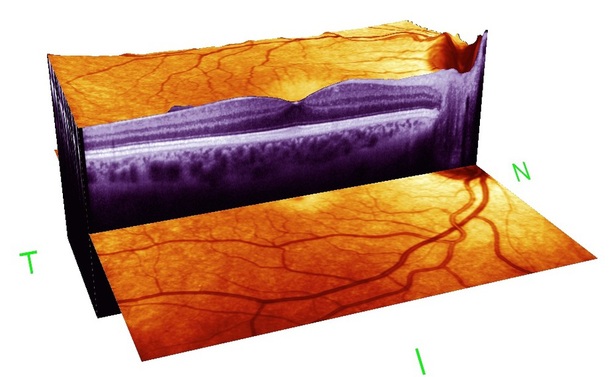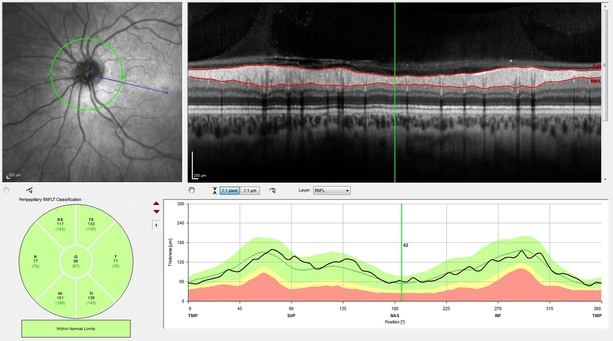Early Glaucoma Detection
Firstly it's worth understanding what glaucoma is, before we explain how important it is to diagnose it early and how we do it... So what is glaucoma?
Glaucoma is a very common eye condition, and is often called the thief of sight as it has no symptoms until it is well established, often creeping up and stealing your sight before you are even aware there is a problem. When symptoms do become noticeable, it's usually only when significant loss of vision (up to 40%) has occurred. It's therefore especially important that everyone at risk understands the need for regular advanced glaucoma eye examinations which can detect the condition long before you can and stop you needlessly losing your sight.
Glaucoma is a major cause of blindness in the world - Primary Open Angle Glaucoma. (POAG) being the most common form.
You do NOT need to have a family history of glaucoma to develop the condition. (although a strong family history does increase your risk)
The prevalence increases with age. Approximately 2% of the population have glaucoma. It is estimated that by 80 years old as many as one in ten people may have the condition (although a significant proportion are undiagnosed).
Glaucoma explained simply- Inside your eye a fluid called the aqueous constantly circulates. This fluid exerts a pressure on the optic nerve at the back of your eye and the fine layers of nerves on your retina all day every day. If this pressure is too high or the nerves at the back of your eye have a weakness the nerve fibers will gradually be compressed. Left undetected or untreated the compression of the nerves causes them to gradually die off and stop functioning- the result of which is losing patches of vision possibly resulting in blindness. Glaucoma can affect anyone but certain groups are more susceptible including those with short-sightedness, poor circulation, diabetes, high blood pressure, migraine sufferers, or of African-Caribbean origin. The good news is that glaucoma is usually very manageable using eye drops and early diagnosis can prevent any significant vision loss at all in 90% of people who are diagnosed early.
Therefore early diagnosis is imperative. Although relevant, the traditional pressure test alone is not an accurate test for glaucoma. You do not need high intra-ocular pressures to develop glaucoma. If you have a nerve weakness, damage can occur even at low pressures. This is called Normal Tension Glaucoma. It is also equally possible to have very high pressures but if the nerves are strong, no damage may occur. This is called Ocular Hypertension.
Most opticians rely on pressure testing and visual field testing to detect glaucoma but using these traditional techniques alone can mean that up to 40% of the nerve fibre layer at the back of the eye may have already been lost by the time the tests show it up. Any nerve damage is permanent and therefore we need to detect nerve damage at a much earlier stage to allow us to save more of your eye sight.
Happily, there is a better way -
New contact lens could save the sight of 320,000 glaucoma sufferers
Glaucoma affects approximately half a million people in the UK, but 300,000 of those with the condition remain undiagnosed. Early diagnosis and precise treatment is imperative. The traditional pressure (IOP) test alone is not an accurate test for glaucoma.
In most cases, glaucoma can be treated effectively with drops, however up to 10% of people (20,000) on treatment will still progress to having further sight loss.
Now Buchanan Optometrists are offering hope to the 300,000 undiagnosed and 20,000 ineffectively treated glaucoma suffers. Using a smart contact lens called Triggerfish, glaucoma can be detected earlier and monitored more easily, allowing quicker diagnosis and changes to current glaucoma patients treatments that can stop progression of the condition.
So why are so many people undiagnosed or receiving ineffective treatment?
Glaucoma Specialist Optician Alisdair Buchanan explains what glaucoma is and the pitfalls in current diagnostic techniques and treatments.
About Intra Ocular Pressures (IOPs)
Glaucoma treatment revolves around lowering your IOP to release the pressure on your retinal nerves, therefore preventing further damage. IOPs are the only controllable factor in glaucoma treatment and therefore they play a significant role in determining the diagnosis and treatment plans for glaucoma. However there is a significant flaw in the current ways IOPs are measured. (This is a large factor in why hundreds of thousands of people are walking around with glaucoma and do not know, and why, despite treatment 10% of patients go on to develop further glaucoma damage that could possibly be prevented.)
The flaw- IOPs are always measured during the day time with the patient sat vertically; this is often when pressures are at their lowest. So at any given visit to an optician or ophthalmologist your IOPs may appear normal only to go home and lie down at night and find the IOPs raise significantly. If the IOPs are unknowingly peaking at night your glaucoma can go undiagnosed or mistreated for years.
Thankfully there is now a way to measure IOPs over 24 hours so we can identify those at risk of the condition much more easily and offer more effective treatment for those diagnosed with glaucoma. A little like blood pressure, eye pressures fluctuate throughout the day and night so having a 24 hour reading is by far the most accurate way of identifying and treating glaucoma.
Buchanan Optometrists are the first and only practice in the UK to offer this advanced technology called Trigger fish. Extensively used worldwide in the diagnosis and monitoring of glaucoma, the 14 mm silicone contact lens contains tiny sensors which monitors the fluctuations in eye pressures over 24 hours. The lens is extremely comfortable to wear even by those who have never worn contact lenses. The specialist optometrist puts the soft contact lens onto your eye and you wear a recorder in your top pocket or around your neck. You carry on your normal activities and sleep pattern whilst you wear the lens. 24 hours later you return, the lens is removed and the recorder sends the results via Bluetooth to our computer system to read the data collected.
How it works
The contact lens sensor measures fluctuations in pressure by observing small changes in the curvature of the cornea (the front of your eye). You cannot feel, see or hear the lens taking measurements. The lens measures for 30 seconds every 5 minutes producing 86,400 readings over a 24-hour period. Readings taken during blinking and other “noise” are filtered out, leaving 288 readings for a 24-hour period. So we have 288 pressure readings rather than the usual 1 that Glaucoma patients traditionally have taken.
The time of day and length of time when peak intraocular pressure occurs and the effect of treatment on this can then be analysed. Treatment plans are then altered to ensure you have the maximum effect from your medication coinciding with your peak IOP. This can prevent glaucomatous damage to the retinal nerves. Following changes to your treatment plans, it is advised to repeat Triggerfish measurements to observe the improvements and ensure effectivity.
The future- How do we know if your Triggerfish measurements and treatments are working to prevent further glaucoma damage?
Rather than monitoring your glaucoma through traditional methods like visual field testing (which can be variable and insensitive to very small fluctuations) we scan your optic nerve and retinal nerve fibres using the new Heidelberg Spectralis Optical Coherence Tomographer 4D eye scanner which uses a very safe low-powered imaging laser, to accurately measure the thickness of the nerve fibre layer. It is a safe, un-invasive technique and doesn’t use any harmful rays like x-rays. It can measure changes as small as 1 micrometer. These scans can detect any nerve damage up to 3-5 years earlier than conventional methods. The scans not only confirm the presence of glaucoma, but also provide a baseline to accurately detect any abnormal loss of nerve fibres in the future thus assessing that IOP management is working. When used in conjunction with Triggerfish IOP monitoring this is considered the most accurate method of glaucoma detection at present. We recommend 4D eye scanning for all patients over 40 and anyone with a family history of glaucoma.
Who should have a Triggerfish assessment?
- Anyone who has been diagnosed with glaucoma and wants to check their treatment is working.
- Glaucoma patients whose condition is progressing despite treatment (if you have had to change your medication or have been told your visual field test has worsened)
- Patients with a family history of glaucoma, even if your pressures are normal.
- Patients being monitored for normal tension glaucoma (you may have been told you have glaucoma or are at risk of it despite normal eye pressures).
- Patients diagnosed with ‘Narrow anterior chambers’ (a condition which can lead to sudden spikes in IOP especially overnight)
Summary of the advantages of Triggerfish:
- Non-invasive and convenient, no puffs of air or discomfort
- Monitoring IOP continuously up to 24 hours
- Recording during sleep and normal activities
- Enables early diagnosis and personalized treatment
- Prevents future glaucoma damage
To find out if you are suitable for Triggerfish IOP monitoring please book a glaucoma assessment:
I have glaucoma - What tests should I have done?
The monitoring of glaucoma in the UK usually quite limited. Normally patients are seen in an NHS setting where they will have their visual fields carried out, visual disc assessment and pressure testing. Additional tests such as Heidelberg spectralis scanning are not currently available under the NHS. Triggerfish 24 hour IOP monitoring is only available privately.
The ideal detection and monitoring plan for anyone at risk of glaucoma, who has glaucoma or wants to find out if they have glaucoma is to have the following battery of tests carried out...
- Humphrey C24-2 Visual Fields
- Humphrey FDF Visual Fields (this is more sensitive to detecting early glaucoma and early changes)
- Goldmann Applanation pressure measurement
- Pachymetry (corneal thickness measurement)
- Anterior Chamber analysis (assessment of the front of the eye)
- Heidelberg Spectralis optic disc retinal nerve fibre analysis
- Heidelberg Spectralis macula retinal nerve fibre analysis
- Heidelberg Multicolour analysis
- Visual Optic disc assessment
- Triggerfish 24 hour pressure assessment
We recommend this should be carried out at least once a year but preferably every 6 months. A full glaucoma assessment which includes all of the above tests except Triggerfish is £290. If you are suitable for Triggerfish IOP monitoring this will be discussed at your assesment and a separate appointment booked. Triggerfish IOP monitoring costs £2000.


Examples of Heidelberg 4D OCT eye scanning.
 Closed angle glaucoma is a rarer form of glaucoma that can cause pain, blurring and quick onset sight loss. We can now scan your eyes and predict the likelihood of this occurring. If the scan identifies a risk you may, at any age, be entitled to preventative laser treatment which can stop closed angle glaucoma from occurring in the future.
Closed angle glaucoma is a rarer form of glaucoma that can cause pain, blurring and quick onset sight loss. We can now scan your eyes and predict the likelihood of this occurring. If the scan identifies a risk you may, at any age, be entitled to preventative laser treatment which can stop closed angle glaucoma from occurring in the future.





